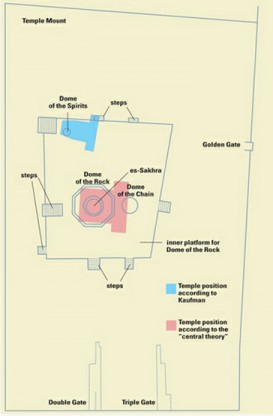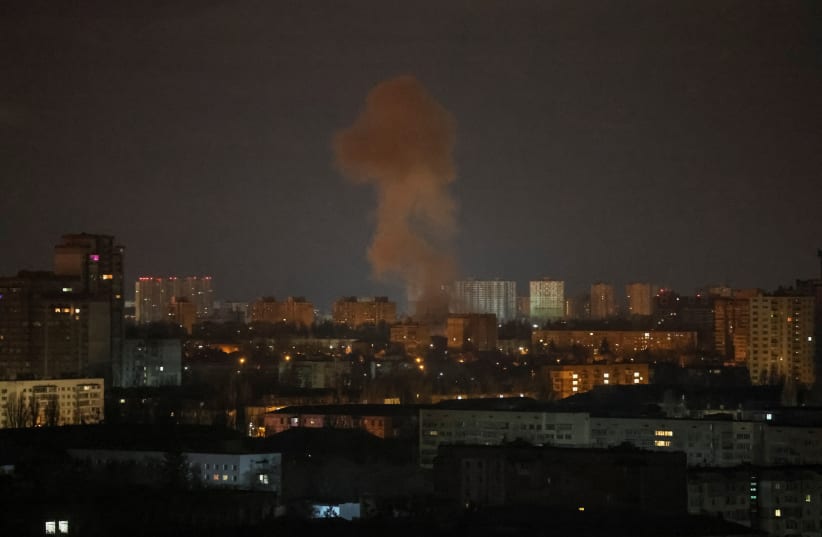"But thou, O Daniel, shut up the words, and seal the book, even to the time of the end: many shall run to and fro, and knowledge shall beincreased STONG’S NUMBER: 7235 rabah, raw-baw´; a primitive root; to increase (in whatever respect):—(bring in) abundance (x -antly), + archer (by mistake for 7232), be in authority, bring up, x continue, enlarge, excel, exceeding(-ly), be full of, (be, make) great(-er, -ly, x -ness), grow up, heap, increase, be long, (be, give, have, make, use) many (a time), (any, be, give, give the, have) more (in number), (ask, be, be so, gather, over, take, yield) much (greater, more), (make to) multiply, nourish, plenty(-eous), x process (of time), sore, store, thoroughly, very. — Daniel 12:4
 Editor’s Note: We have just returned from touring Israel and while on the Temple Mount, we took a compass and stood at the inside the Golden Gate, also known as the Eastern Gate, and sited the Dome of the Spirit. The compass read directly east.
Editor’s Note: We have just returned from touring Israel and while on the Temple Mount, we took a compass and stood at the inside the Golden Gate, also known as the Eastern Gate, and sited the Dome of the Spirit. The compass read directly east.
We then walked to the Dome of The Spirit and sited the Golden Gate and the compass read directly west.
We agree with Professor Kaufman’s theory.
Please read the entire paper that has been posted.
Article Source: Biblical Archaeology Society
There is no site holier for the Jewish people than Jerusalem’s Temple Mount, on which the Biblical and Second Temple period Temples stood. Yet nobody really knows what these Temples looked like or where exactly they stood. While extensive archaeological remains have been found from the Temple Mount area, it is generally accepted that no significant material remains have survived from these Temples.
Lack of information, however, does not necessarily result in a lack of reconstructions or in attempts to pinpoint the location of the Temple and its components. The intrinsic holiness of the Temple for Jews, and even for Christians, ignited religious imaginations and architectural fancy with numerous reconstructions throughout the ages. While these reconstructions might be important for the history of art or the history and practice of religion, they do little in terms of providing a historical understanding of the Temple and Temple Mount.
There is, however, a small community of scholars who engage in the scientific study of the Temple Mount and its relevant texts and who seek to provide solutions to the conundrums of building, place, and location. Asher Selig Kaufman has long been among the leading scholars of this group.
Kaufman’s present book is the third in a series entitled The Temple of Jerusalem. The first two volumes deal with Tractate Middot, the mishnaica tractate that provides a description (of sorts) of the Temple and its courts.1 In the first volume Kaufman provided an eclectic text of Middot with many variant readings and some commentary. In the second volume, he displayed the full, synoptic readings of the variants of Middot, chapters 1 and 2. The rest of the tractate will be published in due course. Both of these volumes were rather short on commentary and explanation, and although Kaufman has been publishing articles on the Temple for many years, it was logical for him to provide, at some point, a systematic presentation of his views. The present volume was originally intended to give the reader a detailed account in English of Kaufman’s Temple and Temple Mount studies, but he decided to make do with an “intermediate publication.”
The core of the books 23 short chapters (and five appendices) is devoted to the location and shape of the Temple and its components: the Inner Court, chambers and gates, the sanctified Outer Court and the water supply. Particular attention is paid to the superimposition of the Temple on the present Temple Mount area, using “archaeological” and literary evidence (Middot and Josephus) when available and necessary. Introductory chapters deal briefly with basic descriptions of the sources, the geographical framework and Temple customs. Concluding chapters deal with later Jewish and Islamic traditions, as well as with “predictions” and a “religious solution” to peace between Jew and Muslims on this contested real estate. Five technical appendices, on such matters as rock levels and dimensions of ashlar stones, conclude the volume.
Kaufman’s work, here and in previous studies, must be understood within the context of his views on the location of the Temple; although these have been known for a good many years, they have been accepted by very few scholars. One of the key elements in attempting to determine the location of the Temple is the Foundation Stone (even shetiyyah). According to Rabbinic tradition, this stone was in the Holy of Holies (or inner sanctum) of the Temple and was three fingerbreadths higher than the ground. The Ark stood upon it in the First Temple and, in the Second Temple period, the fire-pan and incense of the High Priest were placed upon it on the Day of Atonement. According to Rabbi Jose, the world was founded from this spot (Mishnah Yoma 5, 2; Tosefta Kippurim 2, 14). By locating this stone, the site of the Holy of Holies, one could, using literary traditions (as well as “archaeological” remains) plot the location of the Temple, its component parts, courts and much more.

More than 500 years ago, Rabbi David ben Zimra (“Radbaz” [1461–1571]) claimed that the Foundation Stone and Holy of Holies were located within the Dome of the Rock on the Temple Mount. He even identified the Foundation Stone as the stone known as es-Sakhra, the rocky outcropping above which the dome of the rock stands. This view became extremely popular within Rabbinic circles and was also widely accepted by scholars, although both introduced occasional modifications that resulted in differences of opinion over the exact location within what came to be known as the “central location theory.”2 Many of the differences are the result of disagreement over the length of the “cubit,” (the ‘amah of the Rabbis and pexus of Josephus), a key measurement in ancient times. The views range from 0.406 meters (1.33 feet) to 0.66 meters (2.2 feet) per cubit. Kaufman, who as we shall see, does not subscribe to the “central location theory,” is a cubit minimalist, with his cubit measuring 0.437 meters (1.43 feet). While there is still a great deal of controversy on matters of cubit metrology, Herodian or otherwise, a view accepted by many scholars is that of Arye Ben David—that the length of the Temple cubit was 0.56 meters (1.84 feet).3 Needless to say, a change in the length of the cubit affects almost all aspects of location and reconstruction. It is not surprising, therefore, that there is so much disagreement in this matter.
There are two other views regarding the location of the Temple in addition to the “central” theory—the southern and northern theories. Already in 1878, James Ferguson, in his The Temples of the Jews and the Other Buildings in the Haram Area at Jerusalem, suggested that the Temple stood in the southern part of today’s Temple Mount. The major proponent of this view today is architect Tuviah Sagiv. Kaufman is the proponent of the northern location, and he has spent a good many years and a good many pages in this book trying to prove this theory. Thus, according to Kaufman, the Holy of Holies was located at the site of the present-day Temple Mount cupola known as the Dome of the Spirits (also called the Dome of the Tablets) northwest of the Dome of the Rock, and the Foundation Stone is the rock under the Dome of the Spirits. Not wishing to leave es-Sakhra (the rock formation inside the Dome of the Rock) without any function, Kaufman conjectures that it was the Stone of Lost Property mentioned in the Babylonian Talmud from which announcements of found lost property were made.
Since, as mentioned above, Kaufman has been bandying this theory for a good many years, there has already been a good deal of criticism regarding his “northern location theory.” Some of the criticism relates to Kaufman ignoring topographical and geological factors not consistent with his view. Other criticisms claim that Kaufman’s view regarding the location of the Temple makes his reconstruction of the Inner and Outer Courts of the Temple geographically and physically untenable. Finally, there are those who claim that the floor under the Dome of the Spirits is not bedrock, as claimed by Kaufman, but a large paving slab or a stone in some other type of secondary use. While Kaufman responds in the present work to some of this criticism, he is far from thorough or convincing in his replies. (In all fairness, however, it should be pointed out that accepting the views of Kaufman’s critics also requires the occasional [archaeological] leap of faith.)
The second key element in understanding Kaufman’s northern location theory relates to the alignment of the Temple vis-à-vis the Mount of Olives and the ceremony of the burning of the red heifer. Mishnah Parah Chapter 3 describes the ceremony from the beginning until the end. The red heifer’s ashes were mixed with water and sprinkled on the ritually unclean, purifying them. The burning took place on the Mount of Olives, and the priest officiating directed his view to the entrance of the Sanctuary (Hekhal). The eastern wall of the Temple Mount was lower than the others to facilitate this view (Mishnah Middot 2:4; Babylonian Talmud Middot 16a). To determine the approximate location of the Temple, theoretically, all that one must do is to find the spot on which the priest stood and determine his line of vision. This is what Asher Kaufman does in his new volume (and has been doing for a good many years), and this line of vision led him to his northern identification. The only problem is that, with all due respect to the calculations of the author, it is impossible to know where the priest stood on the Mount of Olives. In a previous study, Kaufman suggested that the priest stood near the present-day Church of the Ascension. Others have preferred placing the priest in the area below, near where the Church of Dominus Flevit stands today. When all is said and done, though, Talmudic tradition does not really provide us with enough information about the location of the red heifer ceremony.4
Once Kaufman has located the Temple, he moves on to its alignment and plan, as well as to the Inner Court (‘Azarah) and the “Sanctified Outer Court” (Har Habbayit). All of this is superimposed, a number of times, on the present-day Temple Mount. For the most part, this consists of analyzing literary sources in light of “archaeological” findings, which are part groups of rock-masses that cannot be dated with certainty to the Second Temple period. Sometimes this results in very strange conclusions, such as the placing of the Chambers of the Court of Women outside the Court of Women (pp. 84–85). However, an analysis of Kaufman’s views on these rock-masses, literary sources and subsequent reconstructions would take far more space than allowed here. There is much here that has and will elicit criticism and response.
This book does not make for easy reading, although in Kaufman’s defense it should be pointed out that he makes every effort to be reader-friendly, providing numerous illustrations and explanations. The subject matter is highly technical and detailed, and nothing can be done about this. Also, while Kaufman does make reference to his critics and their criticisms, he does not sufficiently respond to their comments and this is not fair to the reader.
In spite of the above, Asher Kaufman is one of the foremost scholars of the Jerusalem Temple. While one might quibble about this or that reconstruction or calculation, it is important to remember that outside of the world of scientific scholarship, there is a vibrant industry of pseudo-scientific Temple and Temple Mount material being produced and disseminated with great success. While the issues might be complex, it is easier and faster to fantasize than to engage in the type of painstaking research that Asher Kaufman undertakes. We eagerly await his future publications. While we may disagree with him at times, his ongoing contribution to Temple and Temple Mount scholarship cannot be denied.
Notes
1. Asher Selig Kaufman, The Temple of Jerusalem, Part I: Tractate Middot: An Annotated Version Composed from Manuscripts and Early Printed Texts with Introduction, Variant Readings, Family Tree of Texts, Notes and Temple Drawings(Jerusalem: Har Year’ah Press, 1991, in Hebrew); Part II: Tractate Middot: Variant Readings for Chapters 1 and 2 Presented in Novel Form as a Transcript of Manuscripts and Early Printed Texts (Jerusalem: Har Year’ah Press/Gefen, 1997, in Hebrew).
2. The literature is voluminous and beyond the scope of this review. For a good summary of the various theories see Leen and Kathleen Ritmeyer. Secrets of Jerusalem’s Temple Mount (Washington, D.C.: Biblical Archaeology Society, 1998).
3. Arye Ben David, “Ha-Midda ha-Yerushalmit,” Israel Exploration Journal 19 (1969), pp. 159–169; Ben David “The Hebrew-Phoenician Cubit,” Palestine Exploration Quarterly 110 (1978), pp. 27–28. See also Yehoshua Peleg, The Metrology of the Medium Size Cubit from Herod’s Time to the Third Century, unpublished MA dissertation, Bar-Ilan University, 2003, in Hebrew.
4. See Ya’acov Eshel, “Where Did the Kohen Stand on the Mount of Olives?” Judea and Samaria Research Studies, Proceedings of the Seventh Annual Meeting 1997(Kedumim-Ariel: The Research Institute, The College of Judea and Samaria, 1998), in Hebrew, pp. 93–105.
a. The Mishnah is an early Rabbinic law code and forms the basis of the Babylonian and Jerusalem Talmuds.
Joshua Schwartz is dean, faculty of Jewish studies and director of the Ingeborg Rennert Center for Jerusalem Studies at Bar-Ilan University, Israel. He also heads the “Jerusalem Reborn” research project, which seeks to create a virtual reconstruction of the Herodian Temple and Temple Mount.




2 thoughts on “THE TEMPLE MOUNT”
According to some of my Rabbi friends, one of whom has extensively studied the location Solomon’s Temple and the Holy of Holies. There was a story that before the first dome was built and that after the 2nd Temple was destroyed, the old Jewish men that were left in Israel would go to the Even ha-Shtiyya or foundation stone to mourn on Tish B’ Av. It was during this time that Abd al-Malik ibn Marwan ibn al-Hakam noticed these old men weeping and mourning over a stone platform. When he inquired of these mourner’s, they told him that they were mourning over the destruction of the two Temples, the later occurring in in 70 AD, and that the stone where they were gathered was the location of the Holy of Holies.
Abd al-Malik ibn Marwan ibn al-Hakam like all muslims decided to co-op the location and built the first Mosque over top of the stone. Muslims have always destroyed the locations of any other Jewish, Christian, Holy Sites trying to legitimize their young demonic religion by placing a mosque over, or converting existing locations into mosques. The first construction ordered by Abd al-Malik ibn Marwan ibn al-Hakam was started in either 685 or 686 A.D.
A friend of mine who is in Shin Bet (Sherut ha’Bitachon ha’Klali or General Security Service) told me several years ago that there was a plumbing issue in the present day dome and as it was being repaired one of the “plumbers” was able to measure and observe the rock and believes that this is the foundation stone that the Ark of The Covenant rested upon.
I have no reason to doubt my friends and when I was last in Jerusalem about a month ago I saw my friend and he still believed that the mosque still covers the location.
Bravo to those who took their compass and confirmed Kaufman’s theory!
Pingback: united states iptv key